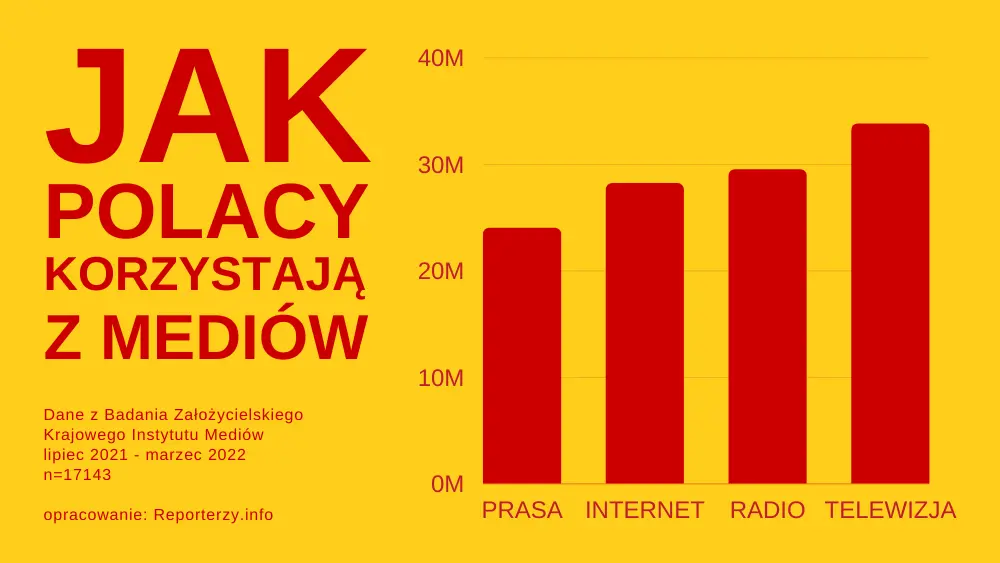 source: National Media Institute, analysis: Reporterzy.info, declarative data for the three months preceding the survey
source: National Media Institute, analysis: Reporterzy.info, declarative data for the three months preceding the surveyThe National Media Institute’s Establishment Survey provides insight into how and how often Poles use traditional and electronic media. Surveyors examined what devices people have at home and what they can access at work or school. The results are as follows:
- Access to TV: 92.0%
- Access to radio: 80.3%
- Access to a computer/tablet: 66.0%
- Access to a mobile phone/smartphone: 88.5%
However, access to a media device does not necessarily mean it is used regularly.
Television
In the 30 days preceding the survey, 90.2% of respondents reported watching television. This translates to 33.1 million Poles, but it’s only 96% of those with access to a TV. Conclusion: two million Poles could watch linear TV but choose not to.
In a longer, three-month period, 92.1% of respondents confirmed watching TV, equating to nearly 33.8 million people. Among age groups, those aged 65+ are the most frequent TV viewers.
- TV viewership by age group
- 4-9 years: 91.5%
- 10-15 years: 95.2%
- 16-24 years: 88.1%
- 25-34 years: 87.0%
- 35-44 years: 90.4%
- 45-54 years: 93.0%
- 55-64 years: 95.2%
- 65+ years: 95.9%
Radio
Radio listening was reported by 75.2% of respondents, meaning that 27.6 million people listened to the radio at least once in the past month. Among radio owners, nearly 8% did not turn on their device even once during the month before the survey.
In a three-month period, the number of radio listeners increases significantly, reaching 80.4% of the population, or 29.5 million people - 1.9 million more than in the one-month period. Radio is least popular among teenagers and most popular among those aged 35-44.
- Radio listenership by age group
- 4-9 years: 71.7%
- 10-15 years: 65.7%
- 16-24 years: 78.5%
- 25-34 years: 83.5%
- 35-44 years: 85.9%
- 45-54 years: 84.4%
- 55-64 years: 82.4%
- 65+ years: 77.9%
Internet
At least 76.8% of respondents use the internet occasionally. In a monthly timeframe, internet users slightly outnumber radio listeners at 28.2 million. According to the National Media Institute, the devices used to access the internet include:
- 26.4 million mobile phone owners (93.9% of internet users)
- 23.6 million computer and tablet owners (83.8% of internet users)
- 15.8 million Smart TV owners (56.2% of internet users)

Over three months, the number of internet users grows by just 300,000, indicating that those who use the internet tend to do so regularly. Among those aged 10 to 50, almost everyone surfs the web. However, over a three-month period, internet usage slightly trails radio usage.
- Internet usage by age group
- 4-9 years: 77.6%
- 10-15 years: 98.6%
- 16-24 years: 99.1%
- 25-34 years: 99.1%
- 35-44 years: 96.5%
- 45-54 years: 89.0%
- 55-64 years: 68.3%
- 65+ years: 28.7%
Print Media
Reaching for newspapers or magazines at least once a quarter is reported by 65.7% of respondents, equating to 24 million readers. Nearly half of this group also reads online editions. Over 11.3 million people, or 31% of the population, read e-publications. The older the age group, the higher the popularity of print media, with readership reaching up to three-quarters among the oldest Poles.
- Print readership by age group
- 4-9 years: 24.6%
- 10-15 years: 45.3%
- 16-24 years: 65.0%
- 25-34 years: 64.9%
- 35-44 years: 69.4%
- 45-54 years: 73.7%
- 55-64 years: 75.3%
- 65+ years: 72.8%
* * *
The National Media Institute’s Establishment Survey was conducted between July 2021 and March 2022 on a representative sample of 17,143 people aged 4 and older. Full results are available at https://kim.gov.pl/wyniki-badan/
COMMERCIAL BREAK
New articles in section Media industry
Dead internet theory is a fact. Bots now outnumber people online
Krzysztof Fiedorek
Already 51% of global internet traffic is generated by bots, not people. As many as two-thirds of accounts on X are likely bots, and on review platforms, three out of ten reviews weren't written by a human. Do you feel something is off online? It's not paranoia. In 2025, it's a reality.
The most valuable female personal brands in Polish fashion. IMM report
KFi
The ten most popular people in Poland in the "fashion" category generate over 1.5 billion contacts across all types of media in a year. Their value is nearly 400 million zlotys. The ranking was prepared by the Institute of Media Monitoring for "Forbes Women" magazine.
Disinformation ranks above terrorism as global threat
KFi
According to "International Opinion on Global Threats" by Pew Research Center, a median of 72% of adults across 25 countries view the spread of false information online as a major threat to their country. That number places disinformation at the very top of perceived global dangers.
See articles on a similar topic:
Digital media addiction. Why the brain can’t cope
KFi
Digital media can hijack the brain's reward system in ways similar to drugs and alcohol, warned psychiatrist and author Anna Lembke. She emphasized that compulsive use of digital platforms can become a serious addiction. Not just a bad habit or risky behavior.
Future of Public Media. Who Will Be Data Ethicists and VR Designers?
KFi
How does the future of work in media look? Here are professions that do not yet exist but will soon become essential. The report "Future Jobs at PSM: Competencies and Professions for the Media of Tomorrow," prepared by the European Broadcasting Union (EBU) and Rai Ufficio Studi, outlines key changes awaiting the public media sector in the coming years.
How Journalists Use Social Media
Bartłomiej Dwornik
Primarily, they seek inspiration from blogs and, less frequently, from Facebook. They rarely trust what they find, often approaching it with caution. Credibility does not necessarily correlate with attractiveness.
Mobile games in Poland. Market value and forecasts
Newseria, KFi
In 2030, the number of mobile game users in Poland may exceed 7.1 million, and market revenue will approach 470 million dollars, according to Statista data. As the number of gamers increases, the market for mobile gaming devices is also expanding.





























